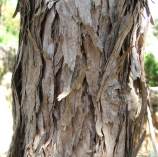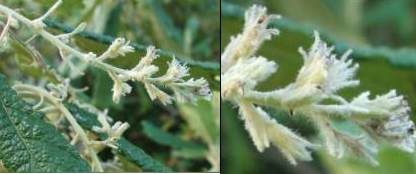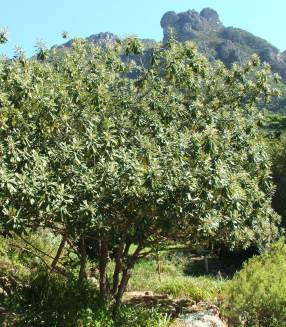Tarchonanthus trilobus var. trilobus
Tarchonanthus trilobus DC. var. trilobus
Family: Asteraceae
Common names: three-lobed tarchonanthus, three-lobed camphor bush, trident camphor bush ( Eng. ), drietandkanferbos (Afr.), isiMemela, iGqeba-lamatshe (Xhosa), isiDuli sehlathi (Zulu)
SA Tree No: 335
Introduction
Tarchonanthus trilobus var. trilobus is a shapely, small, evergreen tree with decorative, aromatic foliage, well-suited to today's smaller gardens.

Description
Description
A shrub or small tree 4 to 8m high with a clean trunk and a dense spreading crown of decorative, bi-coloured leaves. The bark is dark grey, vertically fissured and cracked, flaking off in narrow strips.

The leaves are strongly scented, dark green and wrinkled above, densely velvety-white underneath but with veins and midrib still clearly visible, variable in shape but typically narrow at the base with broad three-lobed tips. Young growth is woolly and cream-white.
Flowerheads are small, thistle-like, yellowish to cream, in branched inflorescences 5-10 cm long, in the axils of the leaves. At Kirstenbosch they flower in autumn-winter (May-June). Tarchonanthus is dioecious, i.e. male and female flowers are carried on different trees. Taking a closer look at the flowerheads requires a magnifying lens as the individual flowers are tiny. Male flowerheads contain 10-16 flowers and are conspicuous and decorative. Each flower has a tubular or funnel-shaped corolla of 5 recurved lobes, covered with woolly hairs on the outside. The anthers taper gradually into a long flat tail-shaped apical appendage. The style is narrowly cylindrical but there is no ovary. The female flowerheads are made up of only 1 flower, and are not decorative. Each flower has a short 4- or 5-lobed corolla tube, covered with woolly hairs on the outside. The style branches are short, flat and egg-shaped and there are no stamens.

The fruit is a thinly woolly nutlet, 5 x 1 mm, inside the fluffy flowerhead. Being familiar with the showy, white, cotton-wool-like fruits of Tarchonanthus littoralis (previously known as T.camphoratus - see the revision by Herman (2002)), I was expecting this species to put on a similar show, but these female fruits are much less woolly and are not showy.
Tarchonanthus trilobus is divided into two varieties: var. trilobus and var. galpinii. At one time they were regarded as two separate species: Tarchonanthus trilobus and T. galpinii.
Tarchonanthus trilobus var.trilobus has leaves with broad three-lobed tips and it has a more southerly distribution, from the Eastern Cape to KZN;
the var. galpinii (broad-leaved camphor bush, breëblaarkanferbos) has oblong, oval or lance-shaped leaves with rounded or pointed tips and it has a more northerly distribution from KZN into Swaziland, Mpumalanga and Limpopo.

Intermediate forms do occur.
Conservation Status
Status
Tarchonanthus trilobus var. trilobus is not threatened.
Distribution and habitat
Distribution description
Tarchonanthus trilobus var. trilobus grows on rocky outcrops, in thicket, in wooded ravines, on hillsides and on forest margins in the Eastern Cape and Kwa-Zulu Natal.
Derivation of name and historical aspects
History
There are two possible explanations for the name Tarchonanthus. One, that it is based on the Arabic name tarchon for Artemisia dracunculus and the Greek anthos meaning flower, alluding to the similarity of the flowerheads of the two species. The other, that it is derived from the Greek tarchos meaning funeral rites, and anthos meaning flower, perhaps due to the camphor scent of the leaves. The species name trilobus means three-lobed in Latin, referring to the typically 3-lobed leaves.
Tarchonanthus belongs in the daisy family. It is a small genus of a few species that occur in tropical and southern Africa. Until recently only two species were recognized in southern Africa: Tarchonanthus camphoratus and T. trilobus but P.P.J. Herman of the National Herbarium in Pretoria, after studying the herbarium material, found that a number of distinct species had been grouped under T. camphoratus.
He revised the Tarchonanthus camphoratus complex in 2002 and, based on differences in inflorescences, flowering times, leaf shape and margin and distribution, now recognizes five species that were all once lumped together under T. camphoratus : T. camphoratus, T. littoralis, T. minor, T. obovatus and T. parvicapitulatus. Thus, today we recognize six southern African species of Tarchonanthus, and T. trilobus is further divided into the two varieties.
Tarchonanthus species are sometimes confused with Brachylaena but they can be told apart as follows: the fruits of Tarchonanthus are enclosed in white wool whereas those of Brachylaena have a bristly (shaving brush-like) pappus, and although the leaves of both genera are fragrant, Tarchonanthus leaves are distinguished by a distinct camphor scent.

Ecology
Ecology
The leaves and stems are browsed by black rhino and other game.
The fruits are light and encased in soft woolly hairs and are readily dispersed by wind.
Uses
Use
Tarchonanthus trilobus wood is bright brown with yellow graining, hard, durable and aromatic, with a lovely camphor scent.
No reference was found to Tarchonanthus trilobus var. trilobus being used medicinally, but T. trilobus var. galpinii and other Tarchonanthus species are used and it is likely that this species is used in a similar way. T. trilobus var. galpinii roots and bark are used to improve libido and for vomiting. The trunk is used for construction, including the building of the King's kraal. T. littoralis is used to perfume women's hair, and smoking dried leaves is said to have a sedative effect. Both T. littoralis and T. camphoratus are used to treat headaches, toothache, abdominal pain and respiratory ailments like asthma, bronchitis and whooping cough, and to make tonics.

Growing Tarchonanthus trilobus var. trilobus
Grow
Tarchonanthus trilobus is a quick-growing, handsome, small tree with a dense crown and curiously shaped, decorative, bi-coloured foliage. It is not common in cultivation, but is an excellent garden subject, is recommended as a street tree and is a good choice for a small suburban garden. It will not get too big and it has non-invasive roots that will not damage paving. It can be pruned and shaped when young. Plant in well-drained, fertile soil in a sunny position. Water generously and deeply during its first few years; once established it requires little maintenance. Although coming from the summer-rainfall region, it grows well in the winter-rainfall Western Cape, coping with the harsh coastal conditions and summer drought. It is frost hardy, but will probably not survive severe frosts and needs protection from frost when young.
Tarchonanthus trilobus var. trilobus is not easily propagated by cuttings, but can be propagated by seed, and young self-sown seedlings transplant easily.
Seed is best sown in spring to early summer. Seed is ripe when the flowerheads detach relatively easily from the inflorescence, i.e. by gently pulling or knocking them off. It is quite a fiddly task to remove the tiny seeds from the woolly flowerheads and they will germinate if sown with the remains of the flowerhead attached provided they do not get too wet and are treated with a fungicide that combats pre-emergence damping off. Use a well-drained sowing medium, cover lightly - enough to stop them from blowing away, keep moist but not wet and in a warm but not hot position. Seedlings can be potted up when they are strong enough to handle.
Tarchonanthus trilobus var. trilobus cuttings do not root easily. Take heel cuttings of semi-hardwood side shoots, in spring, treat with rooting hormone and place under mist using bottom heat. Air-layering trials also yielded poor results in that the cuttings formed a callus but not roots. The most reliable method is to transplant the self-sown seedlings from under the trees.
References
- Coates Palgrave, M. 2002. Keith Coates Palgrave Trees of Southern Africa, edn 3. Struik Publishers, Cape Town.
- Herman, P.P.J. 2002. Revision of the Tarchonanthus camphoratus complex (Asteraceae-Tarchonantheae) in southern Africa. Bothalia 32,1: 21-28.
- Jackson, W.P.U. 1990. Origins and meanings ofnNames of South African plant genera. U.C.T. Printing Dept., Cape Town.
- Leistner, O.A. (ed.) 2000. Seed plants of southern Africa : families and genera. Strelitzia 10. National Botanical Institute, Pretoria.
- Loffler L. & Loffler P. 2005. Swaziland Tree Atlas,SABONET Report No. 35.
- Palmer, E. & Pitman, N. 1972. Trees of Southern Africa. A.A. Balkema, Cape Town.
- Pooley, E. 1993. The complete field guide to trees of Natal, Zululand and Transkei. Natal Flora Publications Trust, Durban.
- Smith, C.A. 1966. Common names of South African plants. Memoirs of the Botanical Survey of South Africa No. 35.
Credits
Alice Notten
Kirstenbosch National Botanical Garden
September 2007
Plant Attributes:
Plant Type: Shrub, Tree
SA Distribution: Eastern Cape, KwaZulu-Natal
Soil type: Sandy
Flowering season: Autumn, Winter
PH:
Flower colour: Cream
Aspect: Full Sun, Morning Sun (Semi Shade), Afternoon Sun (Semi Shade)
Gardening skill: Average
Special Features:
Horticultural zones











Rate this article
Article well written and informative
Rate this plant
Is this an interesting plant?
Login to add your Comment
Back to topNot registered yet? Click here to register.